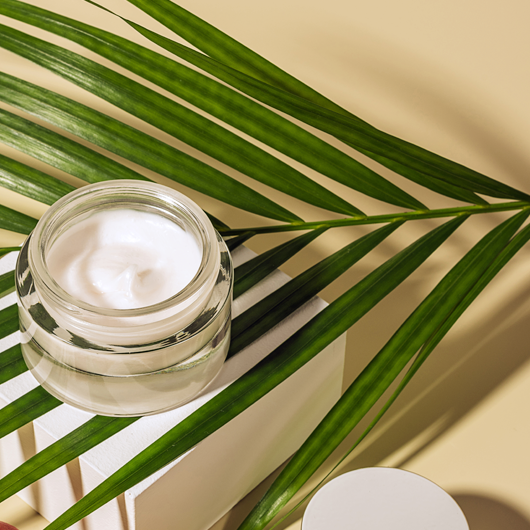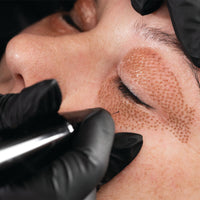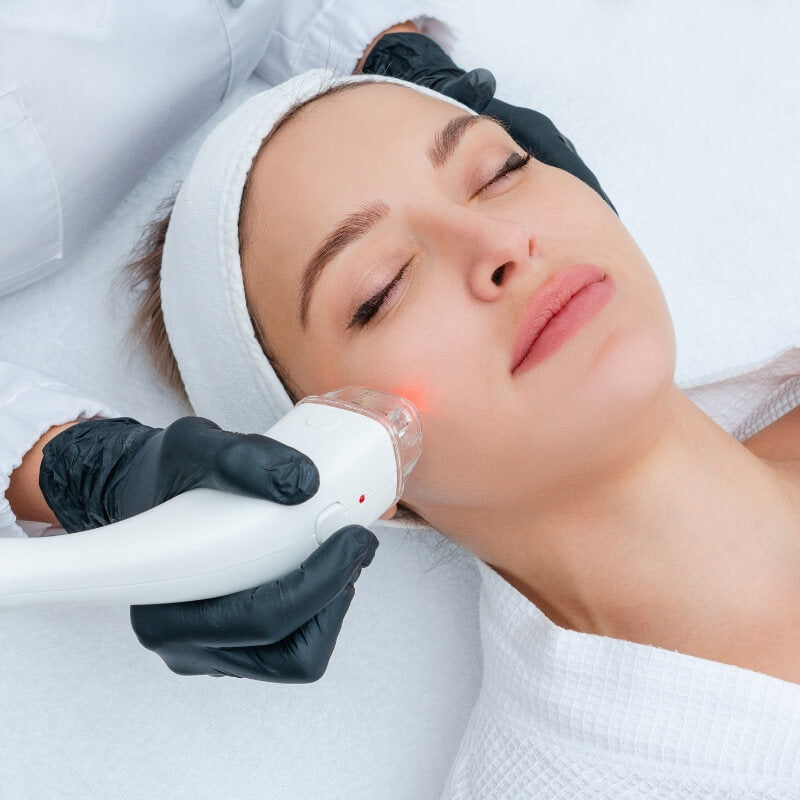Lasers and Resurfacing Facial Treatments
Find out how lasers resurface your complexion with targeted treatments like Fraxel, IPL, RF Protenza, Co2, etc. In addition, a summary of each kind, what they do, who they are for, who is not a good candidate, what technology is used, benefits, cost, and estimated downtime.
If you were to go back in time, even 100 hundred years, and tell others the future would have skin resurfacing treatments that involved laser light beams, can you imagine their amazement?
Skin care technology has greatly evolved in the past century, and continues to grow. The first use of a laser for skin-related concerns was in the 1960s by an American surgeon. Since then, advancements have been made to perfect the technology.
Nowadays, professionals frequently recommend laser treatments and other resurfacing facial treatments to treat various skin conditions, ranging from wirnkles and age spots to acne and melasma (hyperpigmentation caused by hormonal changes.)
Here’s a look at what lasers can do for your skin, the different types on the market, and other resurfacing facial treatments to consider!
What Do Lasers Do To the Skin?
Lasers are a jack-of-all-trades when it comes to skincare. You can not only use lasers to improve the appearance of your skin, but you can use lasers to:
- Remove tattoos
- Remove hair
- Remove warts and moles
- Reduce birthmarks, scars, rosacea, & broken blood vessels (spider veins)
- Treat pre-cancerous areas
- Minimize hyperhidrosis (excessive sweating)
Lasers employ light and heat energy to temporarily signal the skin, so your body’s renewing response generates new skin. This results in the skin appearing younger, clearer, tighter, and healthier!
After a laser treatment, you will receive at-home care instructions to follow for days to come. The regenerating process can last anywhere from 5 to 21 days. This is contingent upon both the laser used and the purpose of your treatment.
DIFFERENT TYPES OF LASERS
Different types of lasers are used, but the two basics ones are ablative and non-ablative lasers. In layman’s terms, ablative lasers work by vaporizing the outer layers of the skin, one by one, while non-ablative lasers work by heating the skin while causing no harm.
Both laser treatments stimulate collagen production and benefit the skin. However, non-ablative lasers produce less visible results because they are less aggressive.
There are also fractionated and non-fractionated lasers. Fractionated lasers enhance the skin by treating small fractions of the skin, while non-fractionated lasers enhance the skin by treating the skin’s entire surface area.
Because non-fractionated laser treatments are more non-invasive than fractionated lasers, they require more recovery time. Moreover, to relive discomfort during the procedure, there is a possibility of receiving a sedative.
CO2 Laser
CO2, or carbon dioxide, laser resurfacing directs light beams to destroy the epidermis, or outermost layer of the skin, via vaporization. As the dermis, or middle layer of the skin, heats up, it stimulates collagen production.
In fact, professionals can accurately address specific areas with CO2 lasers; all without impacting other areas of the skin.
In fact, its wonderful for addressing wrinkles, especially around the eyes and mouth. A study revealed that using a C02 laser improved subject’s facial wrinkles by 45%!
Benefits of CO2 Lasers
-
Wrinkle Reduction: CO2 lasers are highly effective in reducing the appearance of fine lines and wrinkles, including crow's feet and deep-set wrinkles, by stimulating collagen production and resurfacing the skin.
-
Skin Tightening: These lasers can tighten loose or sagging skin, improving overall facial contour and reducing jowls, making the face appear more youthful and lifted.
-
Scar Revision: CO2 lasers can be used to significantly improve the appearance of scars from acne, surgery, or injury by removing the top layers and promoting the growth of new, smoother skin.
-
Pigmentation Correction: They can effectively treat skin discoloration, including sunspots, age spots, and uneven pigmentation, resulting in a more even and radiant complexion.
-
Overall Skin Rejuvenation: CO2 laser treatments can rejuvenate the entire facial skin, addressing multiple concerns simultaneously, such as texture irregularities, premature aging, and overall skin tone, leading to a refreshed and revitalized appearance.
Fractional
Popularized by celebrities like Chelsea Handler, fractional laser resurfacing treatments work by splitting a laser light beam into several smaller beams to create micro-injuries in the skin.
These micro-injuries prompt the body’s natural healing response by telling your body to produce more collagen. Research shows that 80% of volunteer subjects who received fractional laser therapy saw decreased visible aging!
Fractional lasers work wonders on large pores. They strengthen the skin's barrier, and tighten up pores minimizing the look of large pores. In addition, they help reduce redness and improve the evenness of skin tone. This treatment is a must for anyone dealing with hormonal issues or hormone replacement therapy that can increase pore size.
Benefits of Using Fractional Lasers
-
Improved Skin Texture: Fractional lasers can help improve skin texture by stimulating collagen production and promoting the growth of new, healthy skin cells, resulting in smoother and more even skin.
-
Reduced Wrinkles and Fine Lines: They are effective in reducing the appearance of wrinkles and fine lines, making the skin look more youthful and refreshed by encouraging the formation of new collagen fibers.
-
Pore Minimization: Fractional lasers can minimize the appearance of pores. minimizing pores can help by improving the health of the skin which can reduce the appearance of enlarged pores and give the skin a smoother, more refined texture.
-
Treatment of Pigmentation Issues: They can target and reduce the appearance of pigmentation concerns such as sunspots, age spots, and melasma, leading to a more even and balanced skin tone.
-
Minimized Downtime: Fractional laser treatments typically have shorter recovery periods compared to traditional laser resurfacing, making them a more convenient option for those with busy lifestyles, as they can return to their daily activities sooner.
Erbium
Erbium, or Er: YAG, laser resurfacing is similar to CO2 laser resurfacing in that it obliterates the skin to encourage collagen production and healthy skin rejuvenation.
Said to have more precision than a CO2 laser, Erbium lasers can target the skin without harming neighboring skin cells. This precision allows them to treat smaller and more sensitive areas of the skin.
Researchers have even tried combining C02 and Erbium laser technologies to generate a synergistic effect with minimal side effects!
Benefits of Erbium Lasers
-
Precise Skin Resurfacing: Erbium lasers provide precise control over the depth of skin removal, making them effective for targeting superficial and moderate skin issues, such as fine lines, sun damage, and age spots.
-
Reduced Downtime: Compared to some other laser treatments, erbium lasers typically have shorter downtime, allowing patients to recover and return to their daily activities more quickly.
-
Stimulated Collagen Production: Erbium lasers stimulate collagen production in the skin, helping to improve elasticity and firmness while reducing the appearance of wrinkles and fine lines.
-
Minimal Side Effects: These lasers are associated with fewer side effects like redness and swelling, making them suitable for a wider range of skin types and reducing the risk of post-treatment complications.
-
Versatile for Various Skin Concerns: Erbium lasers can effectively address a range of skin concerns, including acne scars, uneven skin tone, and texture irregularities, providing comprehensive facial rejuvenation and skin resurfacing.
IPL
IPL, or intense pulsed light, is a cosmetic treatment comparable to laser therapy, but different. Laser therapy creates an individual wavelength of light energy, whereas light therapy precisely delivers various wavelengths of light energy to the skin.
IPL can treat more of the skin’s surface in less time than laser therapy. With a handheld device, light warms skin cells and wears them down. The body is then triggered to naturally clean out the dull tissue, leading to healthier, more beautiful skin!
This treatment helps reduce redness, even skin tone, and fading sun spots. IPL turns sun spots into a thing of the past. What looks like coffee grounds after a treatment, will slough off after a week or so leaving a fresh, healthier-looking complexion.
No matter your laser treatment, the key is to do multiple treatments. One session does not cut it. Typically, a six-treatment series is suggested. It is a commitment of time and money, but in the end, the results will speak for themselves.
-
Age Spots: IPL lasers can effectively target and reduce the appearance of sunspots, age spots, and freckles, restoring a more even skin tone and minimizing the effects of sun damage.
-
Reduction of Facial Redness: IPL can treat facial redness caused by conditions like rosacea or broken blood vessels, leading to a more even complexion and reduced redness and flushing.
-
Collagen Stimulation: IPL treatments can stimulate collagen production in the skin, improving skin elasticity and reducing the appearance of fine lines and wrinkles over time.
-
Minimized Pore Size: IPL can improve the overall texture of the skin by reducing pore size and enhancing the skin's smoothness and clarity.
-
Hair Removal: IPL is also commonly used for hair removal on the face, providing a non-invasive method to reduce unwanted facial hair, leaving the skin smoother and hair-free.
OTHER RESURFACING FACIAL TREATMENTS
Chemical peels
You can receive gentle chemical peels on your lunch break. But for more extreme chemical peels, you’ll need up to two weeks of recovery time.
Both work by using skin-safe chemicals to remove layers of the skin to reveal healthier, new skin below.
Reliant upon your skincare goals, you can choose from a variety of peels. Types of chemical peels (in order from weakest to strongest) include alpha hydroxy acid (AHA) peels, beta hydroxy acid (BHA) peels, Jessner peels, trichloroacetic acid (TCA) peels, and phenol peels.
5 Benefits of Using Chemicals Peels vs Cosmetic Lasers
- Cost-Effective: Chemical peels are generally more cost-effective than cosmetic laser treatments, making them a more budget-friendly option for individuals seeking skin rejuvenation.
-
Quick Procedure: Chemical peels are typically quicker to perform than laser treatments, with minimal preparation and shorter downtime, allowing patients to return to their daily routines sooner.
-
Versatility: Chemical peels come in various formulations and strengths, making them versatile for addressing a wide range of skin concerns, including acne scars, hyperpigmentation, and fine lines.
-
Suitable for All Skin Types: Chemical peels can be adapted to suit different skin types and tones, while laser treatments may be less suitable for individuals with darker skin due to the risk of pigmentation changes.
-
Gradual Results: Chemical peels provide more gradual results, which some individuals prefer, as they can avoid sudden and dramatic changes in their appearance. Laser treatments may deliver more immediate results, which can be a preference for others.
Dermabrasion/Microdermabrasion
Dermabrasion is a resurfacing facial treatment that uses a revolving instrument to exfoliate the outer layers of the skin by “sanding” the skin. At the same time, microdermabrasion is the same technique, but less aggressive.
Dermabrasion may require anesthesia to reduce discomfort throughout the treatment. You can expect the recovery to last around two weeks. Conversely, microdermabrasion does not require anesthesia with little recovery time.
Microneedling is a semi-invasive skincare treatment using small needles to create tiny holes in the skin. This harm stimulates the skin’s natural healing response, and collagen and elastic production!
Professional micro needling treatments require a numbing cream to be applied to the skin beforehand. It is normal to experience light bleeding during the procedure. Afterward, you can expect your skin to be sensitive for up to 5 days.
There are at-home microneedling, or derma rolling, devices, but beware only to use a needle length under .5 millimeters. A professional should do any device with a greater needle length.
5 Benefits of Microdermabrasion VS Lasers
-
Minimal Downtime: Microdermabrasion typically has little to no downtime, allowing individuals to return to their regular activities immediately after the treatment, while laser treatments may require some recovery time.
-
Painless Procedure: Microdermabrasion is generally painless and well-tolerated, making it a suitable option for individuals with low pain tolerance or sensitivity, whereas laser treatments may cause some discomfort.
-
Suitable for Various Skin Types: Microdermabrasion is safe for most skin types, including individuals with darker skin tones, whereas certain laser treatments may carry a higher risk of pigmentation changes in individuals with more melanin in their skin.
-
Exfoliation and Texture Improvement: Microdermabrasion provides effective exfoliation, improving skin texture, and helping to reduce the appearance of fine lines, wrinkles, and acne scars.
-
Affordability: Microdermabrasion is often more budget-friendly than many cosmetic laser treatments, making it a cost-effective option for those seeking skin rejuvenation without a significant financial investment.
Would you ever try a laser treatment? What other resurfacing facial treatments would you consider?
Slay the day with amazing, healthy skin!
Sources:
https://www.dermatologytimes.com/view/history-aesthetic-lasers
https://www.aad.org/public/diseases/a-z/melasma-overview
https://www.aad.org/public/diseases/a-z/skin-conditions-lasers-treat
https://www.everydayhealth.com/skin-beauty/laser-resurfacing-better-skin-9-things-you-must-know/
https://my.clevelandclinic.org/health/treatments/11015-laser-skin-resurfacing
https://www.mayoclinic.org/tests-procedures/laser-resurfacing/about/pac-20385114
https://www.ncbi.nlm.nih.gov/pmc/articles/PMC3580982/
https://www.americanboardcosmeticsurgery.org/skin-resurfacing/the-top-8-things-you-need-to-know-about-laser-skin-resurfacing/
https://www.healthline.com/health/beauty-skin-care/co2-laser#how-it-works
https://www.healthline.com/health/beauty-skin-care/fraxel-treatment#how-does-it-work?
https://www.medicalnewstoday.com/articles/ipl-treatment#how-it-works
https://my.clevelandclinic.org/health/treatments/11010-chemical-peels
https://www.mayoclinic.org/tests-procedures/chemical-peel/about/pac-20393473
https://www.michelegreenmd.com/types-of-chemical-peels
https://www.healthline.com/health/dermabrasion#recovery
https://www.healthline.com/health/microdermabrasion#preparation
Author:
Written by Sara Katharine Creamer ~Licensed Esthetician








